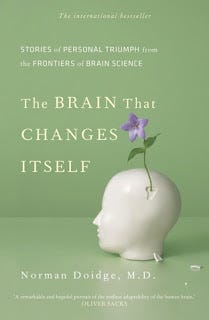Reading about brain plasticity

I am in a book club in which we try to read at least one non-fiction book in a year. I have wanted to read The Brain that Changes Itself by Norman Doidge for a long time, so I suggested it, my suggestion got the vote, and it is our next book. My copy came in the mail on Friday. (I keep telling myself to make better use of the library for books, but since our local one is rather small and pathetic, and every time I’ve gone looking they haven't had the book, I don’t.)
You’ve probably all read this book, as it was something of a sensation a few years ago, but, I must say, I started reading and I am finding it very hard to put down. Maybe you have to have a biological sort of background to get quite this excited, but I am so fascinated! You can read something about the book here and read reviews here (ignore the "the power of positive thinking" reference, as that sounds like simplistic hocus pocus that is not truly representative of the book). The basic gist is that the brain is not nearly so hardwired and mechanistic or compartmentalised as once thought, and that other areas of the brain can learn and be taught to do the work of areas that are injured or non-functioning (and neural pathways can circumvent blocks and find other ways of operating), that weak areas of the brain can be strengthened with exercises just like a muscle, and that brain maps are governed by competition for brain-processing power, such that use it or lose it really does apply (it's not simply that you forget how to do on activity, it's that other activities actually take-over the brain space previously used for that activity, and the reason why it's harder to learn a new language when you are older is because your mother tongue has claimed more territory, so to speak). At least this is what I have learnt so far.
The book is written via the stories of those whose lives have been dramatically changed by implementing the concept of neuroplasticity, so it is a scientific read but in easily digestible format. Chapter two tells the story of the remarkable improvements of a woman, Barbara Arrowsmith Young, with multiple significant learning disabilities who basically designed and implemented her own rehabilitation, and now runs an extraordinary school where they target the areas of brain weakness in those with disabilities. She is actually speaking this year at the Sydney Writer’s Festival and I want to listen.

The book is quite apt right now because even my physiotherapist keeps telling me about training my brain, and how it takes 6-8 weeks for the brain to learn what I am trying to teach it (altering the mechanics of how I stand, walk and run). I intend to read this book and cure myself of all my faults and weaknesses and bad habits (I am kidding – but I can have a shot at it can’t I?). The author does sound a word of caution in the preface with this:
While the human brain has apparently underestimated itself, neuroplasticity isn’t all good news; it renders our brains not only more resourceful but also more vulnerable to outside influences. Neuroplasticity has the power to produce more flexible but also more rigid behaviours – a phenomenon I call “the plastic paradox”. Ironically, some of our most stubborn habits and disorders are products of our plasticity. Once a particular plastic change occurs in the brain and becomes well established, it can prevent other changes from occurring. It is by understanding both the positive and negative effects of plasticity that we can truly understand the extent of human possibilities.
Anyway, got to go. I’ve got eight more chapters to read (I'm only half way through Chapter 3, and there is something on autism coming up, which I expect to be interesting). I am also inspired to keep at things like learning guitar, after reinforcing how good that is for my brain (learning new fine motor skills and auditory skills and how to read a different sort of music ...).

